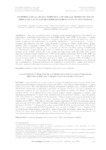Por favor, use este identificador para citar o enlazar este ítem:
http://www.alice.cnptia.embrapa.br/alice/handle/doc/1059817| Título: | Morphological characteristics and forage productivity of irrigated cactus pear under different cutting intensities. |
| Autor: | LIMA, G. F. da C.  REGO, M. M. T.   DANTAS, F. D. G.   LOBO, R. N. B.   SILVA, J. G. M. da   AGUIAR, E. M. de   |
| Afiliación: | GUILHERME FERREIRA DA COSTA LIMA, Emparn - Parnamirim, RN, Brazil; MARGARETH MARIA TELES REGO, Emparn - Parnamirim, RN, Brazil; FERNANDA DANIELE GONÇALVES DANTAS, Universidade Federal Rural de Pernambuco (UFRP) - Recife, PE, Brazil; RAIMUNDO NONATO BRAGA LOBO, CNPC; JOSÉ GERALDO MEDEIROS DA SILVA, Emparn - Parnamirim, RN, Brazil; EMERSON MOREIRA DE AGUIAR, Academic Unit in Agricultural Sciences / Universidade Federal do Rio Grande do Norte (UFRN) - Macaíba - RN, Brazil. |
| Año: | 2016 |
| Referencia: | Revista Caatinga, Mossoró, v. 29, n. 2, p. 481-488, abr./jun. 2016. |
| Descripción: | Abstract: This study evaluated the effect of different cutting intensities and years of harvesting on the morphological characteristics and production of fresh (FMP) and dry matter (DMP) of cactus pear cv. Gigante (Opuntia ficus-indica Mill) under conditions of irrigation, high planting density and fertilization, with 12 months of regrowth. The experimental was completely randomized in a factorial design (3 × 2) with 12 replicates. The treatments were three cutting intensities (preserving the mother cladode (PMC), primary cladodes (PPC), or secondary cladodes (PSC)), and two years of harvesting. The soil was classified as Cambisol Haplicum and the irrigation water was classified as C4S1 (EC 5.25 dS.m-1) density of 50,000 plants ha-1. The research evaluated plant height, number of cladodes per plant (NCP), length, width, perimeter and thickness of the cladodes, cladode area (CA), cladode area index (CAI), FMP and DMP. There was no significant interaction between treatments (P > 0.05) for the variables plant height, NCP, CAI and FMP. The variables related to cladode morphology showed a significant interaction (P < 0.05). The treatment PSC resulted in a greater DMP (P < 0.05) with a mean of 27.17 Mg ha-1 yr-1, compared to PPC (18.58 Mg ha-1 yr-1) or PMC (11.78 Mg ha-1 yr-1). The treatment PSC promoted greater NCP and forage productivity at harvest and can be considered as a management practice for the sustainability of cactus pear cv. Gigante under irrigation. The more important morphological characteristics were also influenced by the lower cutting intensities. [Características morfológicas e produtividade da palma forrageira irrigada submetida a diferentes intensidades de corte]. Resumo: A pesquisa objetivou avaliar o efeito de diferentes intensidades de corte e anos de colheita, sobre características morfológicas e produções de matéria verde (PMV) e seca (PMS) da palma forrageira cv. Gigante (Opuntia ficus-indica Mill) sob condições de irrigação, adensamento e adubação, com 12 meses de rebrota. O delineamento experimental foi inteiramente casualizado em esquema fatorial (3 x 2) com 12 repetições. Os tratamentos constaram de três intensidades de corte (preservando o cladódio mãe (PCM), os cladódios primários (PCP) e os secundários (PCS) e dois anos de colheita. Período experimental 24 meses e duas colheitas com intervalos de 12 meses. O solo foi classificado como Cambissolo Háplico e a água de irrigação C4S1 (CE 5,25 dS.m-1) e densidade de 50.000 plantas ha-1. Foram avaliados: altura e número de cladódios por planta (NCP), comprimento, largura, perímetro, espessura e área dos cladódios (AC), índice de área dos cladódios (IAC), PMV e PMS. Não foi observada interação significativa (P>0,05) dos tratamentos para as variáveis altura, NCP, IAC e PMV. Variáveis relacionadas à morfologia dos cladódios apresentaram interação significativa (P<0,05). O tratamento PCS resultou na maior PMS (P<0,05) com produtividade média de 27,2 Mg ha-1 ano-1, quando comparada à PCP (18,6 Mg ha-1 ano-1) ou PCM (11,8 Mg ha-1 ano-1). O tratamento PCS no momento da colheita promoveu maior NCP e maior produtividade de forragem, sendo uma alternativa de manejo com vistas à sustentabilidade da palma cv. Gigante sob irrigação. As características morfológicas mais importantes também foram influenciadas pelas menores intensidades de corte. |
| Thesagro: | Cactaceae Irrigação Estoque regulador Palma forrageira Planta forrageira Opuntia Ficus Indica |
| NAL Thesaurus: | Irrigation Semiarid zones Cutting Brazil |
| Palabras clave: | Forage reserves Intensidade de corte Semiárido Brasil |
| Tipo de Material: | Artigo de periódico |
| Acceso: | openAccess |
| Aparece en las colecciones: | Artigo em periódico indexado (CNPC)  |
Ficheros en este ítem:
| Fichero | Descripción | Tamaño | Formato | |
|---|---|---|---|---|
| cnpc2016Morphological.pdf | 507.2 kB | Adobe PDF |  Visualizar/Abrir |









